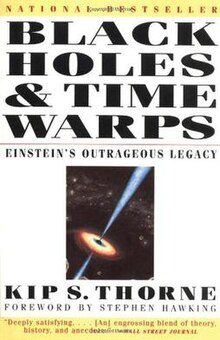
General relativity, also known as the general theory of relativity and Einstein's theory of gravity, is the geometric theory of gravitation published by Albert Einstein in 1915 and is the current description of gravitation in modern physics. General relativity generalizes special relativity and refines Newton's law of universal gravitation, providing a unified description of gravity as a geometric property of space and time or four-dimensional spacetime. In particular, the curvature of spacetime is directly related to the energy and momentum of whatever matter and radiation are present. The relation is specified by the Einstein field equations, a system of second order partial differential equations.

A wormhole is a speculative structure linking disparate points in spacetime, and is based on a special solution of the Einstein field equations.

A gravitational singularity, spacetime singularity or simply singularity is a condition in which gravity is so intense that spacetime itself breaks down catastrophically. As such, a singularity is by definition no longer part of the regular spacetime and cannot be determined by "where" or "when". Trying to find a complete and precise definition of singularities in the theory of general relativity, the current best theory of gravity, remains a difficult problem. A singularity in general relativity can be defined by the scalar invariant curvature becoming infinite or, better, by a geodesic being incomplete.
The following is a timeline of gravitational physics and general relativity.
Timeline of black hole physics

The Large Scale Structure of Space–Time is a 1973 treatise on the theoretical physics of spacetime by the physicist Stephen Hawking and the mathematician George Ellis. It is intended for specialists in general relativity rather than newcomers.

Kip Stephen Thorne is an American theoretical physicist known for his contributions in gravitational physics and astrophysics. A longtime friend and colleague of Stephen Hawking and Carl Sagan, he was the Richard P. Feynman Professor of Theoretical Physics at the California Institute of Technology (Caltech) until 2009 and is one of the world's leading experts on the astrophysical implications of Einstein's general theory of relativity. He continues to do scientific research and scientific consulting, most notably for the Christopher Nolan film Interstellar. Thorne was awarded the 2017 Nobel Prize in Physics along with Rainer Weiss and Barry C. Barish "for decisive contributions to the LIGO detector and the observation of gravitational waves".
In black hole theory, the black hole membrane paradigm is a simplified model, useful for visualising and calculating the effects predicted by quantum mechanics for the exterior physics of black holes, without using quantum-mechanical principles or calculations. It models a black hole as a thin, classically radiating surface at or vanishingly close to the black hole's event horizon. This approach to the theory of black holes was created by Kip S. Thorne, R. H. Price and D. A. Macdonald.

James Burkett Hartle is an American physicist. He has been a professor of physics at the University of California, Santa Barbara since 1966, and he is currently a member of the external faculty of the Santa Fe Institute. Hartle is known for his work in general relativity, astrophysics, and interpretation of quantum mechanics.

General relativity is a theory of gravitation developed by Albert Einstein between 1907 and 1915. The theory of general relativity says that the observed gravitational effect between masses results from their warping of spacetime.

General relativity is a theory of gravitation that was developed by Albert Einstein between 1907 and 1915, with contributions by many others after 1915. According to general relativity, the observed gravitational attraction between masses results from the warping of space and time by those masses.
In physics, there is a speculative hypothesis that, if there were a black hole with the same mass, charge and angular momentum as an electron, it would share other properties of the electron. Most notably, Brandon Carter showed in 1968 that the magnetic moment of such an object would match that of an electron. This is interesting because calculations ignoring special relativity and treating the electron as a small rotating sphere of charge give a magnetic moment that is off by roughly a factor of 2, the so-called gyromagnetic ratio.
A dark star is a theoretical object compatible with Newtonian mechanics that, due to its large mass, has a surface escape velocity that equals or exceeds the speed of light. Whether light is affected by gravity under Newtonian mechanics is unclear but if it were accelerated the same way as projectiles, any light emitted at the surface of a dark star would be trapped by the star's gravity, rendering it dark, hence the name. Dark stars are analogous to black holes in general relativity.
Clifford Martin Will is a Canadian-born theoretical physicist noted for his contributions to general relativity.
A ring singularity or ringularity is the gravitational singularity of a rotating black hole, or a Kerr black hole, that is shaped like a ring.

Gravitation is a widely adopted textbook on Albert Einstein's general theory of relativity, written by Charles W. Misner, Kip S. Thorne, and John Archibald Wheeler. It was originally published by W. H. Freeman and Company in 1973 and reprinted by Princeton University Press in 2017. It is frequently abbreviated MTW after its authors' last names. The cover illustration, drawn by Kenneth Gwin, is a line drawing of an apple with cuts in the skin to show the geodesics on its surface.

General Relativity is a graduate textbook and reference on Albert Einstein's general theory of relativity written by the gravitational physicist Robert Wald.
The following outline is provided as an overview of and topical guide to black holes:

In astrophysics, an event horizon is a boundary beyond which events cannot affect an observer. Wolfgang Rindler coined the term in the 1950s.








